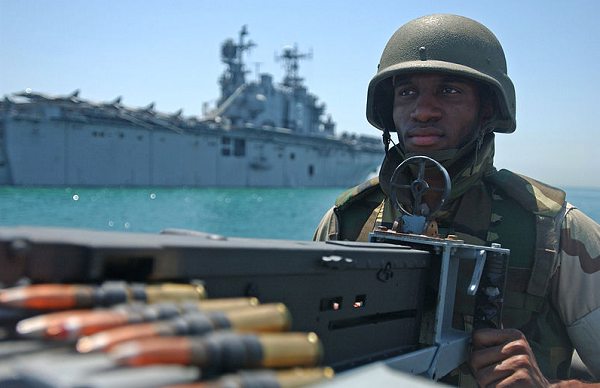A Navy Damage Controlman (FN) is responsible for standing engineering watches and performing minor maintenance repairs.
This rating is part of an apprenticeship opportunity that leads to training in various ratings in propulsion and precision welding/fabrication/plumbing.
Enlistees enter into this career path as Damage Controlman Recruits and complete on-the-job training or technical schooling to enter into an available specialty career for which they both desire and qualify.
Related Article – Navy Undesignated Seaman (SN): Career Details
Qualifications and Training
To enter into this rating individuals must be able to speak clearly, get along with others, have a good memory, physical strength, manual dexterity, and the ability to perform repetitive tasks.
This rating requires a high school diploma.
Individuals must have normal hearing and normal color perception.
Recruits will start by taking the ASVAB test.
After completing entry-level testing and passing all physical/medical requirements, recruits will go to Boot Camp.
Navy Boot Camp is at Great Lakes Naval Training Center in Illinois.
After completing Boot Camp, individuals will go to a 10-week Engineering Common Core course.
This course teaches basic shipboard engineering operation and damage control theory.
When the Damage Controlman is completed with training, they will be assigned to shipboard duties wherever the Navy needs them.
Related Article – Navy A School: A list of all 24 locations
What Does A Navy Damage Controlman Do?
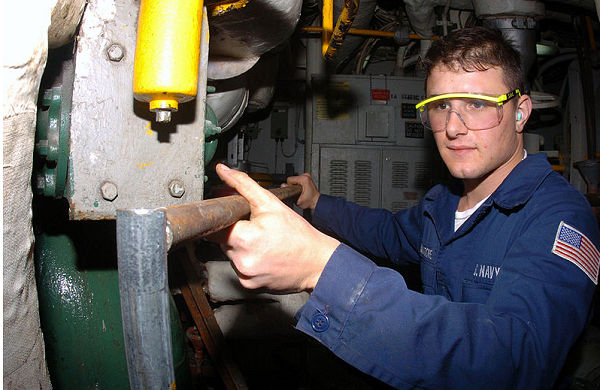
The Navy Damage Controlman (FN) rating allows individuals to seek on-the-job training in a rating they are striking.
Despite the name, this rating is not just about controlling damage.
This path is for individuals who will be striking for other positions.
Part of the job functions include rescue, but the career path is also geared towards engineering.
As with other lower grade ratings, individuals will complete cleaning and painting duties.
Damage Controlmen will stand engineering watches.
They will also stand power plant and ship security watches both while in port and underway.
While performing watches, they will ensure all safety standards are being met with any associated engineering machinery.
They are responsible for working with safety and fire suppression equipment.
A Damage Controlman preserves, maintains, and repairs the safety equipment and any other associated equipment to prepare for underway operations.
In addition to performing maintenance on the equipment, they will also perform any emergency equipment repair.
When working on equipment, they will use different hand and power tools and test equipment.
Part of this role is spent serving as a member of damage control, emergency, and rescue and assistance teams.
The teams assist with underway replenishment including transferring fuel and supplies.
They are required to keep accurate records of maintenance and operation activities plus record accurate readings of gauges.
This includes electronic and written records.
Individuals will find qualified personnel who can help provide on-the-job training geared towards a rating they are interested in.
Ratings that are available in the Damage Controlman Professional Apprenticeship Career Track Program include:
- Engineman (EN)
- Gas Turbine Systems Technician- Mechanical (GSM)
- Gas Turbine Systems Technician- Electrical (GSE)
- Machinist Mate (MM)
- Interior Communications Electrician (IC)
- Damage Controlman (DC)
- Hull Maintenance Technician (HT)
Related Article – Navy vs. Air Force
What Does A Navy Damage Controlman Get Paid?
Those who enlist as a Navy Damage Controlman will start as an E-1 Recruit.
They will advance to E-2 Apprentice after nine months of successful service.
After an additional nine months of successful service, individuals may advance to E-3.
Those with no prior military experience can expect to be paid just over $1,900 a month.
The base pay table for enlisted members can be found below.
| Insignia | Pay Grade | Rank | Abbreviation | 2023 Minimum Monthly Pay |
|---|---|---|---|---|
| N/A | E-1 +4 months | Seaman Recruit | SR | $1,917.60 |
| E-2 | Seaman Apprentice | SA | $2,149.20 | |
| E-3 | Seaman | SN | $2,259.90 | |
| E-4 | Petty Officer Third Class | PO3 | $2,503.50 | |
| E-5 | Petty Officer Second Class | PO2 | $2,730.30 | |
| E-6 | Petty Officer First Class | PO1 | $2,980.50 | |
| E-7 | Chief Petty Officer | CPO | $3,445.80 | |
| E-8 | Senior Chief Petty Officer | SCPO | $4,957.20 | |
| E-9 | Master Chief Petty Officer | MCPO | $6,055.50 | |
| E-9 | Command Master Chief Petty Officer | CMDCM | $6,055.50 | |
| E-9 | Master Chief Petty Officer Of The Navy | MCPON | $6,055.50 |
Benefits
Base pay is not all that the Navy provides.
Depending on the needs of the Navy, individuals can receive a bonus of up to $40,000 for in-demand ratings.
The Navy provides health insurance and full coverage at military hospitals.
They also provide housing or housing allowance, meals (or meal allowance), and a uniform replacement allowance.
You’ll also receive full health and dental care, low-cost life insurance, retirement, travel opportunities, and 30 days paid vacation per year.
Job Reviews
Reviews on this position depend on the career path and where you are located.
Most reviews are very positive but can change based on influential factors such as leadership, location, and available opportunities.
Common topics discussed in reviews include a teamwork atmosphere and the opportunity to learn life skills.
The reviews below provide positive aspects of the position.
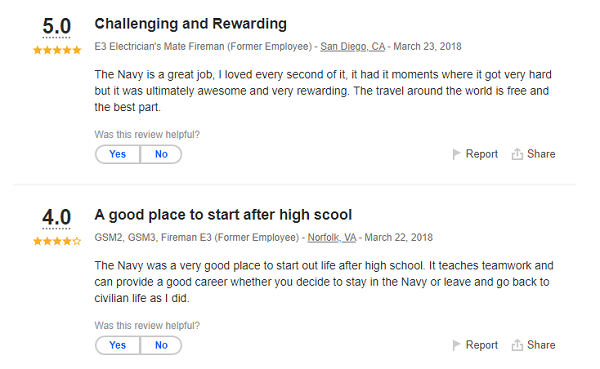
The two reviews below provide the pros and cons of the position.
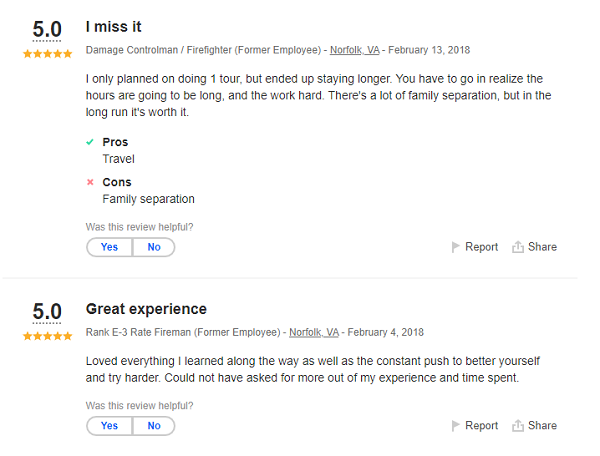
Related Article – US Navy Ships Serviceman (SH): Career Details
Civilian Career Opportunities
The civilian career opportunities available to those in this rating depend on the career path that they choose.
The skills learned as a Damage Controlman relate to mechanic positions, electrical system repair, and entry-level emergency positions.
Once individuals advance into the ratings they are striking for other civilian opportunities that will be available to them.
These opportunities include gas turbine repair technicians, electricians, and fabrication welders.
The Navy provides opportunities to earn Department of Labor nationally recognized apprenticeships through USMAP.
They also provide additional credentialing opportunities and career advancement assistance through Navy COOL.
Summary
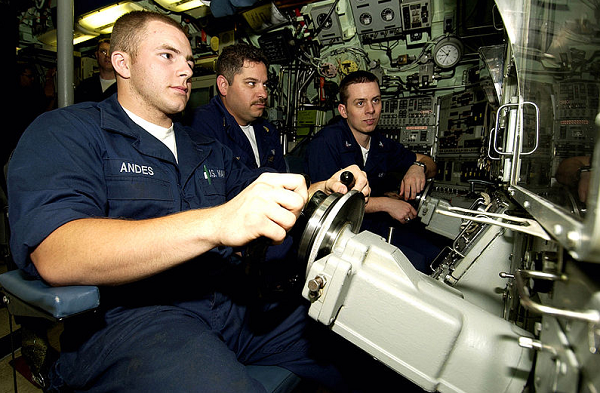
Navy Damage Controlmen (FN) are responsible for completing engineering watches, operating electrical equipment, and completing repairs.
The Damage Controlman Professional Career Track (PACT) training allows individuals to complete on-the-job training for several careers.
This rating is open to those with a high school diploma and requires recruit training and an Engineering Common Core course.
Reviews on this rating vary based on the career path chosen.
Most reviews are positive and discuss the team atmosphere.
After working as a Navy Fireman, individuals will have skills related to mechanics, electrical, engineering, and emergency response.
Related Article – Navy Career Counselor: Career Details
References
- Navy Promotion Timeline for Enlisted & Officers - June 19, 2024
- Navy SEAL Training (BUD/S) - June 19, 2024
- Navy Aircraft Carrier Flight Deck Shirt Colors Explained - June 19, 2024
Originally posted on December 30, 2019 @ 6:12 am
Affiliate Disclosure: This post may contain affiliate links. If you click and purchase, I may receive a small commission at no extra cost to you. I only recommend products I have personally vetted. Learn more.
